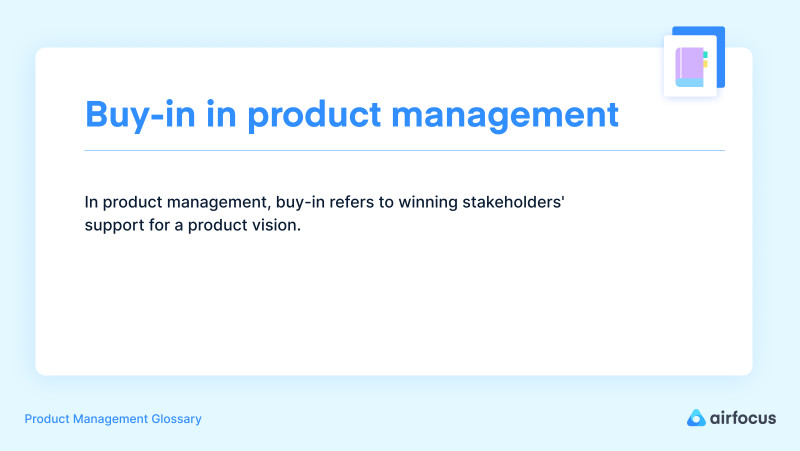Buy-In in Product Management
What is buy-in in product management and why is it important?
Buy-in in product management Definition
In product management, buy-in refers to winning stakeholders' support for a product vision. This support could be a financial investment that enables a business to fully realize a concept. Or it could simply be a team member’s belief in, and commitment to, a vision that motivates them to do their best.
Why is buy-in in product management so important?
Because it demonstrates that the people responsible for bringing a product to market are working to achieve success and understand the value of their goal. Without support from stakeholders, it can be tough to complete objectives and unlock a product’s full potential.
Key stakeholders for buy-in
Before you can encourage buy-in in product management, you need to determine your key stakeholders. These are:
Engineering team (software developers, analytics specialists, and designers)
Executives (managers, leaders, and any other decision-makers)
Sales
Marketing
When you identify your key stakeholders, you need a clear plan to achieve buy-in.
Strategies for achieving buy-in
Get individual buy-in first
Don’t rush into a major pitch to 20 people — start with just a few individuals. Approach them one at a time and convince them about your idea/plans. This is a great way to get early feedback, refine your idea, and build a better pitch.
Don't be afraid to back your pitch
When you pitch your product idea, people will disagree with you. But don't be afraid to argue your side and do your best to persuade them. You believe in your idea, and with a little more information, they may, too.
However, leave space to hear their opinions and concerns. Other people’s knowledge and perspectives could open your eyes to oversights and new possibilities. Address those concerns that you have answers for, and come back to those you don’t.
Know your stakeholders
Tailor your pitch to the individuals you're talking to, their priorities, and how they communicate. Use terminology they’ll understand, focus on the benefits that motivate them, and try to address concerns they’re likely to have before they raise them.
Communication best practices for buy-in
Be prepared
Be clear on who you’ll be talking to before you try to get buy-in. Consider what they care about, what motivates them, and why they should care about your product vision. Bring along any supporters you already have for extra credibility.
Use visuals and words harmoniously
Don’t just tell stakeholders about your idea. Show them your idea! Use visual aids, prototypes, and demonstrations to show it off. Clarify what the product can do and why they should support it.
Get confirmation of buy-in in writing
When stakeholders buy into your vision, ask them to formally confirm it in a written document. This prompts people to think things through more carefully before they agree to support an idea, and it can reduce the risk of disappointments later on.

General FAQ

Glossary categories
Create effective product strategy

Experience the new way of doing product management








